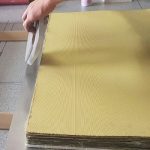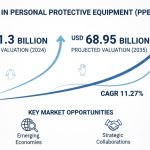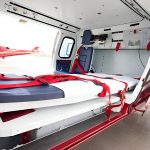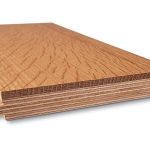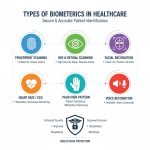Advanced Wound Care Market Poised for Robust Growth: Projected to Reach USD 20.6 Billion by 2035
The global advanced wound care market is experiencing significant growth, driven by rising prevalence of chronic wounds, an aging population, and increasing adoption of innovative wound management solutions. Advanced wound care products, including moist wound dressings, bioengineered skin substitutes, and negative pressure wound therapy (NPWT) devices, are improving patient outcomes by accelerating healing and reducing complications. In 2024, the market was valued at USD 11.4 billion and is projected to reach USD 20.6 billion by 2035, growing at a CAGR of 7.7% during the forecast period, reflecting strong demand across hospitals, home healthcare, and specialty clinics worldwide.
Our comprehensive Advanced Wound Care Market report is ready with the latest trends, growth opportunities, and strategic analysis. View Sample Report PDF.
Key Takeaways
- The advanced wound care market is projected to grow from USD 11.4 billion in 2024 to USD 20.6 billion by 2035, with a CAGR of 7.7%.
- The moist wound care segment held the largest market share in 2024, while the active wound care segment is expected to witness the fastest growth during the forecast period.
- Hospitals were the leading end-users in 2024, with the home healthcare segment expected to experience the highest growth rate in the coming years.
- North America led the market with largest market share in 2024, while Asia Pacific is projected to be the fastest-growing region during the forecast period.
Premium Insights
The advanced wound care market is evolving with the integration of innovative technologies such as bioengineered skin substitutes and negative pressure wound therapy (NPWT). These advancements are enhancing the healing process and reducing complications associated with chronic wounds. Additionally, the increasing prevalence of diabetes and other chronic diseases is driving the demand for advanced wound care products.
The market was valued at USD 11.4 billion in 2024 and is projected to reach USD 20.6 billion by 2035, growing at a CAGR of 7.7% from 2025 to 2035. The advanced wound care market is characterized by a mix of established players and emerging companies. Key players include Smith & Nephew, Mölnlycke Health Care, and 3M, among others. These companies are focusing on product innovation, strategic partnerships, and geographic expansion to strengthen their market position.
For Advanced Wound Care Market Research Report and updates detailed: View Full Report Now!
Product Insights
The product segment includes moist wound care and active wound care. Moist wound care, such as hydrocolloid and hydrogel dressings, maintains an optimal healing environment and accounted for the largest market share in 2024. Active wound care, including bioengineered skin substitutes and NPWT devices, actively promotes tissue regeneration and is expected to grow rapidly due to technological advancements and increasing demand for faster, more effective wound management solutions.
Wound Type Insights
Wound types are classified into chronic wounds and acute wounds. Chronic wounds, including diabetic foot ulcers, venous leg ulcers, and pressure ulcers, dominate the market due to the rising prevalence of diabetes and aging populations. Acute wounds, caused by trauma or surgical procedures, are expected to witness the fastest growth, driven by increasing surgical interventions, trauma incidents, and awareness about rapid wound healing solutions.
End-User Insights
End-users include hospitals, home healthcare, and specialty clinics. Hospitals lead adoption due to high patient volumes and established wound care protocols. Home healthcare is experiencing rapid growth, fueled by an aging population and preference for at-home treatments. Specialty clinics are expanding adoption of advanced wound care products for chronic wound management, preventive care, and improved patient outcomes, creating significant opportunities across all end-use segments globally.
Regional Insights
North America Advanced Wound Care Trends
North America dominated the advanced wound care market in 2024, holding the largest share due to well-established healthcare infrastructure, high awareness of chronic wound management, and early adoption of innovative products like NPWT devices and bioengineered skin substitutes. Government programs promoting chronic disease management and reimbursement policies further support growth. Hospitals and home healthcare providers are increasingly integrating advanced wound care solutions to enhance patient outcomes and reduce hospitalization durations.
Europe Advanced Wound Care Trends
Europe holds a significant share of the market, with countries like Germany, the UK, and France leading in adoption of advanced wound care products. Strong healthcare systems, government initiatives for chronic wound management, and well-established reimbursement frameworks support market expansion. Hospitals and specialty clinics are investing in advanced dressings and NPWT technologies to improve healing rates, while patient awareness campaigns further drive adoption across the region.
Asia Pacific Advanced Wound Care Trends
The Asia Pacific region is projected to be the fastest-growing market, driven by rising prevalence of diabetes, an aging population, and improving healthcare infrastructure in countries such as China, India, and Japan. Increasing awareness about chronic wound management, growing private healthcare facilities, and adoption of advanced wound care products like bioengineered skin substitutes and moist dressings are key factors. The region also presents opportunities for home healthcare services as at-home care gains popularity.
Latin America Advanced Wound Care Trends
Latin America is witnessing steady growth, led by Brazil and Mexico, where rising awareness of chronic wounds and expanding healthcare access are key drivers. Hospitals and diagnostic centers are increasingly adopting advanced wound care solutions to improve healing outcomes. While infrastructure and reimbursement challenges exist, growing demand for preventive care and chronic wound management products supports market expansion across the region.
Middle East & Africa Advanced Wound Care Trends
The Middle East & Africa region is emerging as a growth market due to increasing healthcare investments, government support for chronic disease management, and rising awareness about advanced wound care therapies. Countries such as the UAE, Saudi Arabia, and South Africa are seeing increased adoption of NPWT devices, bioengineered skin substitutes, and modern dressings in hospitals and specialty clinics, creating new opportunities despite challenges in healthcare accessibility and infrastructure disparities.
Key Advanced Wound Care Company Insights
Key Companies
- 3M Company
- Smith & Nephew PLC
- ConvaTec Group PLC
- Coloplast A/S
- Molnlycke Health Care AB
- Integra LifeSciences Holdings Corporation
- PAUL Hartmann AG
- B. Braun Melsungen AG
- Cardinal Health Inc.
- Organogenesis Holdings Inc.
- Misonix Inc.
- MiMedx Group Inc
- Zimmer Biomet Holdings Inc.
- Lohmann & Rauscher GmbH & Co. KG
- DeRoyal Industries Inc.
- Medline Industries Inc.
- DermaRite Industries LLC
Recent Developments
- In 2024, Smith & Nephew launched a new range of antimicrobial dressings designed to reduce infection rates in chronic wounds.
Advanced Wound Care Market Report Scope
Vantage Market Research provides a comprehensive analysis of the Advanced Wound Care Market, covering key trends, opportunities, and competitive landscape across the globe. The report examines market performance from 2024 to 2034, segmented by Product Type (Moist and Active Wound Care), Wound Type (Chronic and Acute), End-User (Hospitals, Home Healthcare, Specialty Clinics), and Region (North America, Europe, Asia Pacific, Latin America, Middle East & Africa). It offers detailed revenue forecasts, CAGR projections, and insights into emerging technologies, regulatory frameworks, and market dynamics shaping global growth.
Market Dynamics
Driver:
The growth of the advanced wound care market is primarily driven by the rising prevalence of chronic diseases, such as diabetes, obesity, and cardiovascular conditions, which increase the risk of chronic wounds. Technological innovations like bioengineered skin substitutes, negative pressure wound therapy (NPWT), and antimicrobial dressings improve healing rates and reduce complications. Additionally, growing awareness among patients and healthcare providers about early intervention and effective wound management supports strong market adoption globally.
Restraint:
High costs associated with advanced wound care products, including NPWT devices and bioengineered dressings, remain a significant restraint, especially in developing regions. Limited reimbursement policies, lack of skilled healthcare professionals, and concerns about procedural complexity hinder widespread adoption. Furthermore, infrastructure constraints in rural and low-income regions restrict access to advanced wound care, slowing market penetration and limiting growth potential in certain geographies.
Opportunity:
Emerging markets in Asia Pacific, Latin America, and the Middle East & Africa present substantial growth opportunities due to increasing healthcare investments, rising awareness of chronic wound management, and expanding private healthcare facilities. Innovations such as AI-assisted wound monitoring, portable NPWT devices, and advanced hydrogel formulations provide avenues for differentiation and broader adoption. Home healthcare services also offer opportunities as patient preference shifts toward at-home wound care solutions.
Challenges:
The market faces challenges such as stringent regulatory requirements for medical devices and advanced wound care products, high R&D costs, and the need for continuous product innovation. Ensuring proper training for healthcare professionals and maintaining patient safety while delivering effective treatments are critical hurdles. Additionally, competition from conventional wound care products and regional variations in healthcare infrastructure and reimbursement policies can limit market expansion and adoption rates.
Global Advanced Wound Care Market Report Segmentation
- By Product Type: Dressings, Devices & Accessories, Grafts & Matrices, Topical Agents
- By Wound Type: Surgical & Traumatic Wounds, Diabetic Foot Ulcers, Pressure Ulcers, Venous Leg Ulcers, Burns & Other Wounds
- By End-Use: Hospitals, Home Healthcare, Others
- By Region: North America, Europe, Asia Pacific, Latin America, Middle East & Africa
Frequently Asked Questions
Q1: What is the projected growth rate of the advanced wound care market?
A1: The market is projected to grow at a CAGR of 7.7% from 2025 to 2034.
Q2: Which region holds the largest market share in advanced wound care?
A2: North America held the largest market share with a 46% share in 2024.
Q3: What are the key drivers of market growth?
A3: Key drivers include the increasing prevalence of chronic diseases and technological advancements in wound care products.
Q4: Which segment is expected to witness the fastest growth?
A4: The active wound care segment is expected to witness the fastest growth during the forecast period.
Q5: What are the challenges faced by the market?
A5: Challenges include high product costs and regulatory hurdles in product approvals.
![[Market Research Reports] – Research Google News Blog | VMR.Biz](https://www.vmr.biz/wp-content/uploads/2022/12/logo-removebg-preview.png)


